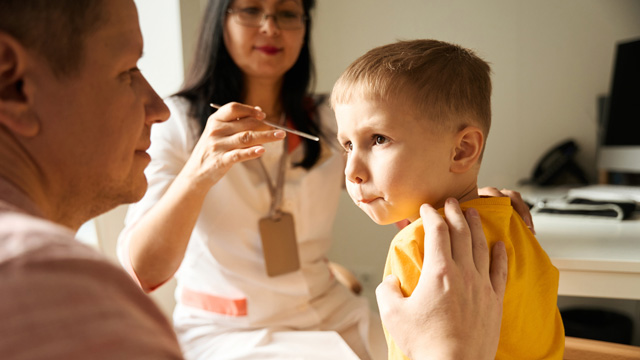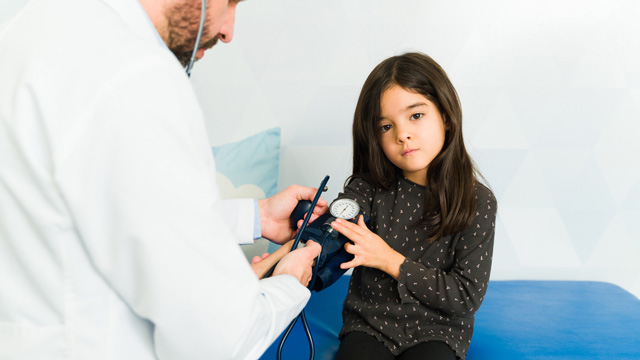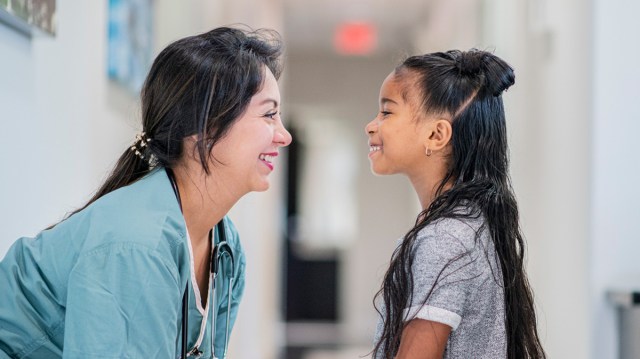While you can always expose your child to some episodes of Doc McStuffins to ease anxieties about going to the doctor, there are still some medical procedures and protocols that kids may find daunting
Let’s be honest… even as an adult, going to the doctor’s office can be scary. Shots and other medical procedures, beeping noises, and blood droplets are just a few unpleasantries that typically accompany a check-up or sick visit. Now imagine how your little one feels about all this: they leave a waiting room filled with vibrant colors and endless toys and enter a sterile environment for an appointment with a person they barely know, with little to no input into what’s going on.
“Fear of the unknown is worse than knowing what to anticipate so framing things in a positive light and without too much detail is best. Explanations need to be at the level of understanding for the child’s age, so keeping them simple and light,” says Denise Scott, MD, a pediatrician with JustAnswer and author of Feed Your Child’s Future Health, Prevent Disease Before It Starts.
To help prepare kids for scary blood draws, shots, and other things, we spoke with pediatricians to find out how to make a child feel most comfortable during these (potentially) scary medical procedures.
Shots and Blood Draws

Two common medical procedures call for needles: shots and blood draws. This can be anything from the flu shot to the tetanus shot and a comprehensive blood panel at a checkup. While they may be scary, it’s important to let your kiddo know what to expect.
“For shots and blood draws, let them know they can scream and cry and do not have to watch but they need to hold very still. Tell them it will feel like a quick pinch or the snap of a rubber band, and you can even demonstrate this to yourself or your child if they are willing,” says Scott.
Additionally, you’ll also want to explain to them how keeping an arm or leg loose and relaxed rather than tensing the muscle can help make the process easier for both parties.
To help ease the pain afterward, have the option of fun Band-Aids to choose from and perhaps a lollipop on standby. These types of distractions will help your child forget about the minuscule amount of pain they just experienced.
X-Rays
If a child happens to break or fracture a bone, then an X-ray is typically a standard medical procedure done at the doctor’s office or in an emergency room. Some kids might find seeing a detailed image of their bones to be fascinating, however, other kids may not be as interested.
“It’s super important that your child keeps very still when getting X-rays, so the picture is clear. Plus, getting it right the first time limits their exposure to radiation,” says Harvey Karp, MD, pediatrician and CEO of Happiest Baby.
For school-age kids, Karps suggests explaining that getting an X-ray is like playing freeze tag, and they’ve been tagged. You can tell them that as soon as the picture is taken, the X-ray tech will “unfreeze” them.
“In certain circumstances, wrapping your child—no matter their age—swaddle-style may also help them stay still and feel calm,” says Karp.
Nose and Throat Swabs

Whether your child needs to be tested for COVID or strep throat, that typically requires throat and nose swabs. This can be both scary and uncomfortable for a child, but Krupa Playforth, MD, a board-certified pediatrician and founder of The Pediatrician Mom has a few pointers to make the process easier.
“My favorite trick for throat swabs is to tell kids to “pant like a puppy” or “roar like a dinosaur” during the actual swab. This serves two purposes: first, it actually opens the mouth wider and elevates the palate, making it easier to do a swab quickly and efficiently because you can visualize what you’re doing better. Second, it serves as a comical distraction for many children, which also helps prevent them from shaking their head or batting away the swab.”
Karp adds to tell your kids to keep their eyes open during the swab to prevent gagging— for help with this you’ll want to pick a spot on the ceiling to have them look at.
Stitches
For those children who are prone to long and deep cuts, they must get stitches to aid in safe and quick healing. Now the thought of stitches can be scary, especially because a child typically isn’t under general anesthesia during this in-office medical procedure.
Small children may have to lay on a papoose board to control their movements. It is like a swaddle for a big kid and is invaluable to the physician to prevent unwanted movement in the arms and legs.
“A parent can help by talking or singing to the child, holding a video for them to watch (if not in the way), or using other forms of distraction,” says Karp. “The child should be aware that they will get a little sting, then the medicine will take the pain away so they do not feel anything.”
Blood Pressure Cuffs

Your child will probably be triaged before seeing the doctor and this typically includes taking a temperature, checking the oxygen level, and getting a blood pressure reading. This might seem like a breeze for adults, but kids may not understand the concept of the cuff squeezing their arm.
“I help them anticipate this by saying that their arm will get a big hug with a special balloon, then loosen again,” says Scott.
Karp adds you’ll want to dress your child in a loose-sleeved or short-sleeved shirt to make the test as easy as possible.
Related: Are Your Kids Afraid of the Doctor? Then Play This Game











